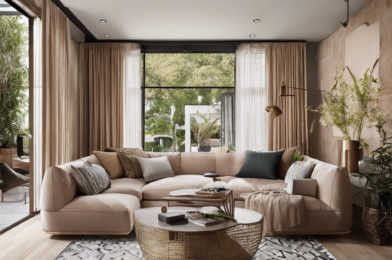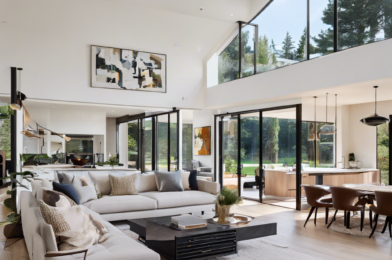**Natural Lighting: Brightening Up Your Dark Spaces**
There’s nothing like natural light to transform a space, bringing warmth and a sense of openness to your home. However, if you have a room that’s lacking in windows or struggles to capture that sunny vibe, don’t despair! There are plenty of tricks to maximize natural light and create a bright and inviting atmosphere.
One of the simplest ways to brighten a dark room is to embrace light, neutral colors. Paint your walls a crisp white or a soft beige to instantly reflect and enhance any natural light that enters the room. Light colors make a space feel airy and more expansive, whereas darker shades tend to absorb light, making a room feel smaller and gloomier. This principle also applies to your choice of furniture and decor – opt for lighter colored pieces, especially larger items like sofas and curtains, to keep the space bright and welcoming.
Mirrors are another great tool to maximize natural light. Strategically place mirrors across from windows to reflect the outdoors and create the illusion of additional light and space. The larger the mirror, the more dramatic the effect, and you can also experiment with multiple mirrors to create a unique feature wall. Don’t be afraid to think outside the box – mirrored closet doors or even mirrored backsplashes in the kitchen can make a huge difference in how light and spacious a room feels.
Window treatments play a significant role in controlling natural light. Heavy, opaque curtains might be perfect for blocking out the sun in a bedroom, but in darker rooms, sheerer options are often better. Opt for lightweight, sheer curtains that allow sunlight to filter through, brightening the space even when they’re closed. Sheer curtains also provide privacy while still letting in plenty of daylight. Blinds are another good choice, especially if they can be adjusted to let in light while maintaining privacy, such as Venetian or vertical blinds.
Don’t forget about the power of skylights and solar tubes. Skylights are a fantastic way to bring in natural light from above, and they’re especially effective in rooms where privacy is a concern, such as bathrooms and bedrooms. Solar tubes, also known as sun tunnels, are a similar concept but tend to be more affordable and flexible. They capture sunlight via a dome on the roof and then direct it down a reflective tube into the room, providing bright, natural light even in spaces without direct roof access.
If your home has small windows, consider enlarging them to let in more light. While this may be a more significant renovation project, it can totally transform your space, making it feel more open and airy. Alternatively, you can visually enlarge your windows with clever tricks, such as mounting curtains higher and wider than the actual window frame. This gives the illusion of a larger window and draws the eye upward, creating the perception of more space.
Another way to maximize the impact of your windows is to keep the frames and sills light and bright. Dark window frames, while stylish, can make a space feel smaller and heavier. Opt for white or light-colored frames, and ensure the sills are clutter-free to allow as much light as possible to stream into the room. Regularly clean your windows, inside and out, to remove any grime that might be blocking precious sunlight.
Let’s not forget about the power of artificial lighting to enhance natural light. Strategic use of lamps and light fixtures can make a huge difference, especially in the darker corners of a room. Place lamps near windows, preferably on either end of a sofa or large piece of furniture, to create the illusion of more light pouring in. Use light-colored lampshades that allow light to filter through, and consider adding a mirror behind the lamp to reflect even more brightness.
When it comes to light bulbs, look for those that mimic natural daylight. Bulbs with a color temperature of 5000-6500 Kelvin will provide a bright, white light similar to the sun, whereas warmer bulbs (2700-3000K) give off a softer, more yellowish light like that of incandescent bulbs. The higher the lumens (brightness) of the bulb, the brighter your space will be, so opt for higher lumens in darker rooms.
Speaking of bulbs, don’t underestimate the power of a well-placed accent light. Highlighting a particular feature or area can make the whole room feel brighter and more inviting. Consider adding lights inside glass-fronted cabinets or underneath shelves to create a bright and airy display. LED strip lights are perfect for this purpose and can be easily installed almost anywhere you want to bring attention.
In addition to mirrors, you can also use reflective surfaces and accessories to amplify the natural light in a room. Glass-topped tables, glossy finishes on furniture, and metallic accents like picture frames or decorative objects will all bounce light around, brightening up darker corners. Even something as simple as a collection of glass vases on a windowsill can help to reflect and disperse sunlight throughout the space.
If you’re able to renovate or are in the process of building your home, consider adding more windows or French doors to increase the amount of natural light in your space. Large sliding glass doors are a great option for bringing in ample light while also providing a view and access to the outdoors. Skylights, as mentioned earlier, are another excellent way to flood your rooms with sunlight from above.
For those with smaller spaces or limited window options, there’s another clever architectural trick you can employ – the light well. Light wells are narrow shafts that extend from the ceiling down through the floors of a building, often with a skylight at the top. They bring natural light deep into the home, brightening areas that would otherwise be quite dark. Light wells are commonly used in townhouses and apartments to provide light to stairwells, hallways, and internal rooms.
Sometimes, the issue of a dark room isn’t the amount of light coming in, but rather the view being blocked by large pieces of furniture. Assess the layout of your room and consider whether any bulky items, like sofas or entertainment units, might be obstructing the path of natural light. Can you rearrange the space to allow more light to filter through? Even something as simple as moving a large plant or floor lamp can make a difference in how bright the room feels.
On that note, don’t forget the impact of nature! Adding some greenery to your space not only provides a pop of color and life but can also help to bring in more light. Place potted plants near windows, or if you’re feeling adventurous, create a sun-soaking indoor garden. Large, leafy plants with light-colored leaves will reflect sunlight and brighten up the room, all while purifying the air. Just be mindful of placing them in areas that receive adequate sunlight or provide supplemental lighting to keep them happy and healthy.
If you’re looking for a more permanent solution to your dark room dilemma, you might consider a home addition or renovation project. Adding a sunroom or conservatory is a wonderful way to bring in natural light and create a bright, airy space that can be enjoyed all year round. Sunrooms are designed to maximize sunlight and often feature large windows and skylights, providing the perfect spot to relax and soak up some rays, even during colder months.
Finally, don’t neglect the power of a good clean. A dirty window or dusty lampshade can block more light than you might think! Regularly clean your light fixtures, lamps, and windows to ensure they’re shining at their brightest. This includes any light bulbs you have – over time, they can become cloudy or dusty, reducing their effectiveness. A quick wipe down with a microfiber cloth will have them shining like new.
There you have it! By using these natural light tricks, you can transform even the darkest of rooms into a bright and inviting space. Remember to embrace light colors, mirrors, and strategic window treatments, and don’t be afraid to get creative with reflective surfaces and clever architectural design. With these tips, you’ll be maximizing the natural light in your home and enjoying a brighter, more welcoming atmosphere in no time.
Stay bright!
(Please note that this article provides general advice and may not be applicable to all homes or situations. For more specific guidance, consider consulting an interior designer or lighting specialist.)









